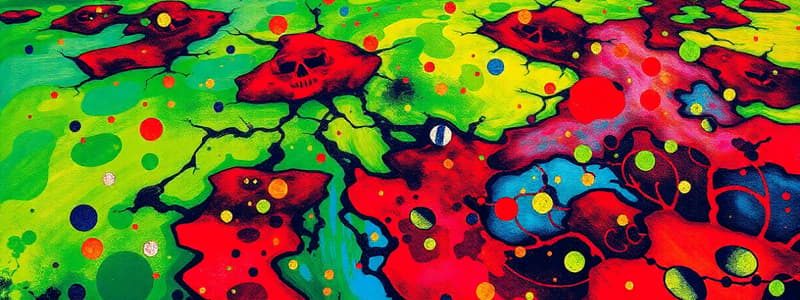Podcast
Questions and Answers
Which of the following is a characteristic of dead zones (hypoxic zones) in the ocean?
Which of the following is a characteristic of dead zones (hypoxic zones) in the ocean?
- Thriving animal life
- Absence of chemical nutrients
- Very low oxygen concentrations (correct)
- High oxygen concentrations
Bioremediation involves introducing more toxic substances to break down contaminants.
Bioremediation involves introducing more toxic substances to break down contaminants.
False (B)
What is the primary difference between in-situ and ex-situ bioremediation?
What is the primary difference between in-situ and ex-situ bioremediation?
In-situ bioremediation treats contaminants at the site, while ex-situ bioremediation involves removing the contaminated material for treatment elsewhere.
The introduction of microorganisms to a contaminated site to enhance the degradation process is known as ______.
The introduction of microorganisms to a contaminated site to enhance the degradation process is known as ______.
Match the following air pollutants with their source:
Match the following air pollutants with their source:
What is the key difference between primary and secondary air pollutants?
What is the key difference between primary and secondary air pollutants?
Quantitative air pollutants are always man-made and do not occur naturally.
Quantitative air pollutants are always man-made and do not occur naturally.
Explain how the size of particulate matter (PM) affects its potential for causing health issues.
Explain how the size of particulate matter (PM) affects its potential for causing health issues.
The process of adding special chemicals to combine fine particles and colloidal suspensions into larger particles during water treatment is called ______.
The process of adding special chemicals to combine fine particles and colloidal suspensions into larger particles during water treatment is called ______.
Which of the following is a potential effect of thermal pollution on aquatic ecosystems?
Which of the following is a potential effect of thermal pollution on aquatic ecosystems?
Flashcards
Dead Zones
Dead Zones
Areas in the ocean with very low oxygen concentration; also known as biological deserts or hypoxic zones.
Bioremediation
Bioremediation
Uses microorganisms to degrade environmental contaminants into less toxic forms; often uses genetic engineering techniques.
In Situ Bioremediation
In Situ Bioremediation
Bioremediation that occurs at the site of contamination.
Land Farming
Land Farming
Signup and view all the flashcards
Primary Pollutants
Primary Pollutants
Signup and view all the flashcards
Secondary Pollutants
Secondary Pollutants
Signup and view all the flashcards
Fly Ash
Fly Ash
Signup and view all the flashcards
Marine Pollution
Marine Pollution
Signup and view all the flashcards
Oil Spill
Oil Spill
Signup and view all the flashcards
Community Waste Water
Community Waste Water
Signup and view all the flashcards
Study Notes
- Dead Zones: Are areas in the ocean with very low oxygen concentration.
- Dead zones are also known as biological deserts or hypoxic zones.
- They emerge when the influx of excess chemical nutrients spurs algae growth (algal blooms).
- These zones usually occur 200-800 meters (in the saltwater layer) below the surface.
- Hypoxic zones can occur naturally due to the upwelling of excess nutrients.
- Dead zones can be created or enhanced by human activity.
- Dead zones are detrimental to animal life because most of the animal life either dies or migrates from the zone.
Bioremediation
- Uses microorganisms (bacteria and fungi) to degrade environmental contaminants into less toxic forms.
- Microorganisms can be specifically designed for bioremediation using genetic engineering techniques.
Types of Bioremediation
- In situ bioremediation: Occurs at the site of contamination.
- Bioventing supplies nutrients through wells to contaminated soil to stimulate the growth of bacteria.
- Biosparging injects air under pressure below the water table to increase groundwater oxygen concentrations.
- This enhances the rate of biological degradation of contaminants by bacteria.
- Bioaugmentation imports microorganisms to a contaminated site to enhance the degradation process.
- Ex-situ bioremediation: Involves the removal of the contaminated material to be treated elsewhere.
- Land farming excavates contaminated soil and spreads it over a prepared bed, periodically tilling until pollutants are degraded.
- The goal is to stimulate indigenous biodegradative microorganisms and facilitate their aerobic degradation of contaminants.
- Bioreactors process contaminated solid material (soil, sediment, sludge) or water through an engineered containment system.
- Composting is nature's recycling of decomposed organic materials into a rich soil known as compost.
Air Pollutants
- Refer to the undesirable changes in the physical and chemical constituents of air due to human activities.
- Primary pollutants: Direct emission from the atmosphere, for example: CO, SO₂, NOx, PM
- Secondary pollutants: Reaction with atmospheric pollutants, for example: Ozone, PAN
Mode of Release
- Indoor: Cooking, smoking, air conditioning, etc., for example: CO, CO₂, VOCs, etc.
- Outdoor: Industrial processes, transportation, for example: PM, CO, VOCs, etc.
Chemical Composition
- Particulate Matter: Solid or liquid aerosol, for example: PM2.5, PM10
- Gaseous: Miscible with air in vapor form, for example: SOx, Ozone, NOx, CO, etc.
Basis of Persistence
- Primary Pollutants: Persist in the form in which they are added to the environment, e.g., DDT, plastic.
- Secondary Pollutants: Formed by interaction among the primary pollutants, e.g., Peroxyacetyl Nitrate (PAN) is formed by the interaction of Nitrogen Oxides and Hydrocarbons.
Basis of Existence in Nature
- Quantitative Pollutants: Occur in nature and become pollutants when concentration reaches beyond a threshold level, e.g., Carbon Dioxide, Nitrogen Oxide.
- Qualitative Pollutants: Man-Made, do not occur in nature, e.g., Fungicides, herbicides, DDT etc.
Basis of Biodegradability
- Biodegradable Pollutants: Waste products degraded by natural process microbial action, e.g., sewage.
- Non-Biodegradable Pollutants: Pollutants which don't decompose naturally or decompose slowly e.g. plastics, polythene bags, DDT etc.
Basis of Origin
- Natural: Released during natural processes, such as volcanic eruptions, forest fires or grass fires etc.
- Anthropogenic: Released during anthropogenic activities, such as CO₂ emissions from the burning of fossil fuels.
Sources of Air Pollution
- Natural Sources: Ash from burning volcanoes, dust from storms, forest fires, pollen grains from flowers in air.
- Human Sources:
- Power stations using coal or crude oil release CO₂ in air.
- Furnaces using coal, cattle dung cakes, firewood, kerosene, etc.
- Steam engines used in railways, steamers, motor vehicles, etc. give out CO₂.
- Motor and internal combustion engines which run on petrol, diesel, kerosene.
- Vegetable oils, kerosene, and coal as household fuels.
- Sewers and domestic drains emanating foul gases.
- Pesticide residues in air.
- Emissions from agriculture, waste treatment and biomass burning (stubble burning).
Types of Particulate Pollutants
- Particulate Pollutants: Matter suspended in the air such as dust and soot.
- Major sources of suspended particulate matter (SPM) are industries, vehicles, power plants, construction activities, oil refineries, railway yards, marketplaces, industries, etc.
- PM10: Inhalable particles with diameters generally 10 micrometers and smaller, come from dust stirred up from construction sites, pollen, or emissions from vehicles and industrial processes.
- PM2.5: Fine inhalable particles with diameters generally 2.5 micrometers and smaller, result of combustion processes like burning fossil fuels, vehicle emissions, or even cooking.
- PM2.5 particles can penetrate deep into our lungs and even enter our bloodstream, causing more severe health issues.
Fly Ash
- End product of combustion during the process of power generation in coal-based thermal power plants.
- Composition: Consists of silica, alumina, oxides of iron, calcium, and magnesium and toxic heavy metals like lead, mercury, cadmium, arsenic, cobalt and copper.
- Uses: Manufacturing of Portland Cement, bricks/blocks/tiles manufacturing, road embankment construction and low-lying area development, etc.
- ASH TRACK Mobile App: Launched by the Ministry of Power for better management of fly ash produced by thermal power plants by providing an interface between fly ash producers (Thermal Power Plants) and potential ash users such as road contractors, cement plants etc.
Fluorides
- Sources: Aluminum, steel and electrochemical plants, blast furnaces, brick kilns, coal combustion, tile and glass etching factories.
- Volcanoes also releases fluorides which form gaseous as well as particulate pollutant.
- Impact: Fluoride particles settle on vegetation, burn tips of leaves, when cattle eat it, they suffer from fluorosis resulting in loss of teeth, weight and lameness.
Water Pollutants
- Pathogens: Sources are sewage, human and animal wastes, natural and urban runoff from land, industrial waste.
- Effects: Depletion of dissolved oxygen in water (foul odor), health effects (outbreaks of waterborne diseases).
- Organic pollutants: Sources are automobile and machine waste, tanker spills, offshore oil leakage, and chemicals used for better yield from agriculture.
- Effects: Disruption of marine life and aesthetic damage. -Toxic effects (harmful for aquatic life), possible genetic defects and cancer, kills fish
- Inorganic pollutants: Sources are agricultural runoff fertilizers (phosphates and nitrates).
- Effects: Eutrophication, aesthetics, algal bloom and eutrophication, nitrates cause methemoglobinemia.
- Acids and alkalies: Sources are Mine drainage, industrial wastes, natural and urban runoff.
- Effects: Kill fresh water organisms, unfit for drinking, irrigation and industrial use.
- Radioactive materials: Sources are natural sources, uranium mining and processing, hospitals and research laboratories using radioisotopes.
- Effects: Cancer and genetic defects.
- Heat: Sources are cooling water for industrial, nuclear and thermal plants.
- Effects: Decreases solubility of oxygen in water, disrupts aquatic ecosystems.
- Sediments: Sources are natural erosion, runoff from agricultural land and construction sites.
- Effects: Affects water quality, reduces fish population.
Water Pollution Control Measures
- When waste water is dumped into a river the treatment is carried out by sedimentation, coagulation and filtration, known as primary treatment.
- If water is required for drinking, it goes through further treatments called secondary and tertiary treatments.
Primary Treatment
- Sedimentation: Polluted water is allowed to settle so that silt, clay and other matter settle to the bottom and water is slowly allowed to move out,
- Fine particles do not settle and are removed in the next step.
- Coagulation: Fine particles and colloidal suspension are combined into large particles by a process called coagulation.
- Addition of special chemicals called coagulants (flocculants) like potash alum.
- The large particles either settle to the bottom or move in the next step.
- Filtration: Suspended particles, flocculants, bacteria and other organisms are filtered by passing the water through a bed of sand or finely divided coal or through some fibrous materials.
- Total impurities collected in these steps are called sludge, used as a valuable fertilizer.
Secondary Treatment
- Undesirable cations of calcium and magnesium are removed from hard waters.
- Soft water is exposed to air by forcing air through it to add oxygen to water.
- This encourages bacterial decomposition of organic matter into harmless products such as carbon dioxide and water.
- The addition of oxygen reduces carbon dioxide, sulphide etc.
Tertiary Treatment
- Chlorine is the most commonly used disinfectant used for killing bacteria.
- Other methods of disinfection such as ultraviolet radiation, ozone gas treatment or reverse osmosis are preferred over chlorine treatment.
Cleaning Oil Spills
- Skimmers are used to physically retrieve oil by separating them from the water
- Sorbents are used to absorb oil from the surface, for example volcanic ash.
- Chemical surfactants can associate oil into smaller particles to accelerate their dispersion.
- Biological cleaning agents as microorganisms are used to speed up natural biodegradation.
- Examples of bacteria used are Paraperlucidibaca, Oleispira, Thalassolituus zhongshania, among others, to help remove classes of contaminents.
- Related regulation: No law covering oil spill as such and it's consequential environmental damage in India.
- In 2015, India ratified the international convention on civil liability for bunker oil pollution damage, 2001 (Bunker convention).
- The convention ensures adequate, prompt and effective compensation for damage caused by oil spills.
Heavy Metals Ions In Water
| Heavy metal Ion | Common Sources |
|---|---|
| Copper (Cu) | Fertilizers, tanning, and photovoltaic cells |
| Zinc (Zn) | Soldering, cosmetics, and pigments |
| Silver (Ag) | Refining of copper, gold, nickel, zinc, jewelry, and electroplating industries |
| Chromium (Cr) | Leather industry, tanning, and chrome plating industries |
| Arsenic (As) | Wooden electricity poles that are treated with arsenic-based preservatives, pesticides, fertilizers, the release of untreated effluents, oxidation of pyrite (FeS) and arsenopyrite (FeAsS) |
| Mercury (Hg) | Combustion of coal, municipal solid waste incineration, and volcanic emissions |
| Cadmium (Cd) | Paints, pigments, electroplated parts, batteries, plastics, synthetic rubber, photographic and engraving process, photoconductors, and photovoltaic cells |
| Lead (Pb) | PVC pipes in sanitation, agriculture, recycled PVC lead paints, jewelry, lead batteries, lunch boxes, etc. |
Agricultural Sources of Water Pollution
- Fertilizers consisting of major nutrients such as nitrogen, phosphorus, and potassium.
- Pesticides consisting of chlorinated hydrocarbons, organophosphates, metallic salts, carbonates, thiocarbonates, derivatives of acetic acid, etc.
- Animal excreta such as dung.
- Excess nitrate in drinking water reacts with hemoglobin to form non-functional methaemoglobin and impairs oxygen transport, this condition is called Methemoglobinemia or blue baby syndrome.
- High levels of nitrates may form carcinogens and can accelerate eutrophication.
Thermal Pollution
- From thermal power plants and nuclear plants releasing hot waters which decreases dissolved oxygen in the water.
Marine Pollution
- Includes coastal city sewage and garbage disposal, as well as navigational discharge of oil, detergents, and radioactive waste.
Oil Spills
- Refers to any uncontrolled release of crude oil, gasoline, fuel, or other oil byproducts into the atmosphere, the oil spills can contaminate land, air, or water.
- Major environmental problem, chiefly as a result of intensified petroleum exploration and production on continental shelves and the transport of large amounts of oils in vessesl.
- Prevents sufficient sunlight from penetrating the surface, and also reduces the level of dissolved oxygen.
- Contains many different toxic compounds which can cause serious health problems such as heart damage, stunted growth, immune system effects, and even death.
Methods to Clean Oil Spills
- Oil booms - floating barriers called booms are used to stop spreading oil which could be retrieved.
Sources of Water Pollution
- Community waste water: Includes discharges from houses, commercial and industrial establishments connected to public sewerage system, consists of human and animal excreta, food residues, cleaning agents, detergents and other wastes.
- Industrial waste: Discharges several inorganic and organic pollutants.
Types of Industrial Waste
| Type of Industry | Inorganic pollutants | Organic pollutants |
|---|---|---|
| Mining | Mine Wastes: Chlorides, various metals, ferrous sulphate, sulphuric acid, hydrogen sulphide, ferric hydroxide, surface wash offs, suspended solids, chlorides and heavy metals. | |
| Iron and Steel | Suspended solids, iron cyanide, thiocyanate, sulphides, oxides of copper, chromium, cadmium, and mercury. | Oil, phenol and neptha |
| Chemical Plants | Various acids and alkalies, chlorides, sulphates, nitrates of metals, phosphorus, fluorine, silica and suspended particles. | Aromatic compounds solvents, organic acids, nitro compound dyes, etc. |
| Pharmaceutical | Proteins, carbohydrates, organic solvent intermediate products, drugs and antibiotics | |
| Soap and Detergent | Tertiary ammonium compounds alkalies | Flats and fatty acids, glycerol, polyphosphates, sulphonated hydrocarbons |
| Food processing | Highly putrescible organic matter and pathogens | |
| Paper and pulp | Sulphides, bleaching liquors. | Cellulose fibres, bark, woods sugars organic acids |
Nature of Pollution
- Any undesirable alteration in the physical, chemical, or biological attributes of air, land, water or soil.
Types of Pollution
- Air pollution, Noise Pollution, Water Pollution, Soil Pollution, Radioactive Pollution, Light pollution and Nitrogen pollution.
Water Pollution
- The presence of undesirable substances/pollutants in water, like organic or inorganic compounds, including biological or radiological materials, which degrade water quality so that it becomes unfit for use.
Sources of Water Pollution
- Point sources: from a single, identifiable source.
- Non-point sources: from diffuse sources, including agricultural runoff, urban runoff, industrial waste water, and atmospheric deposition.
Natural Sources of Water Pollution
- Soil erosion and the leaching of minerals from rocks (due to their natural solubility and solubility triggered by acid rain), and the decaying of organic matter.
Studying That Suits You
Use AI to generate personalized quizzes and flashcards to suit your learning preferences.




